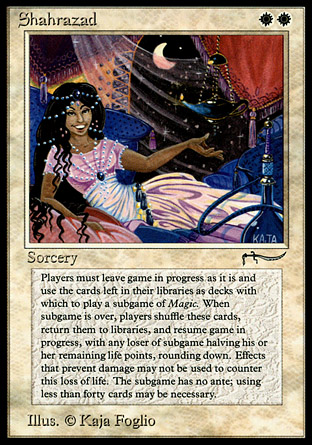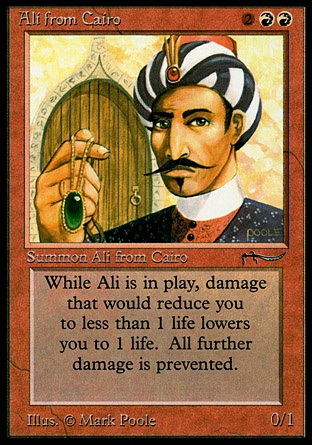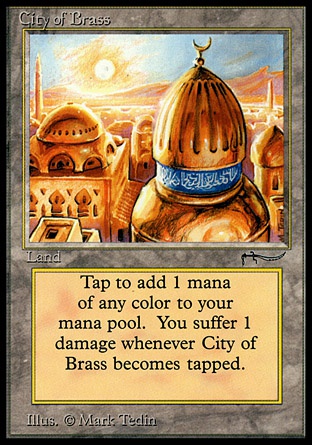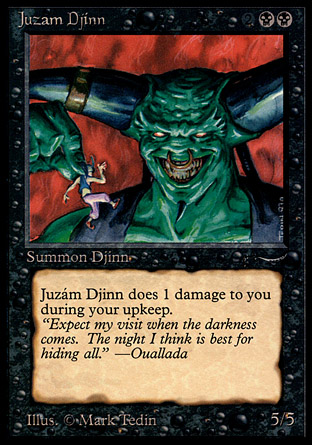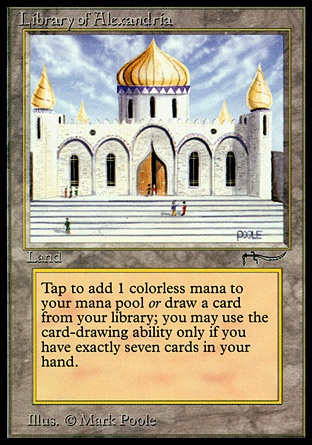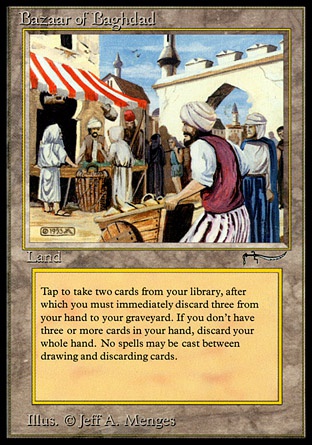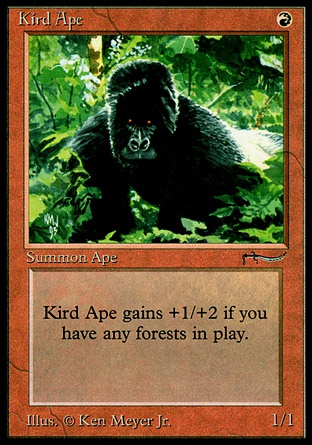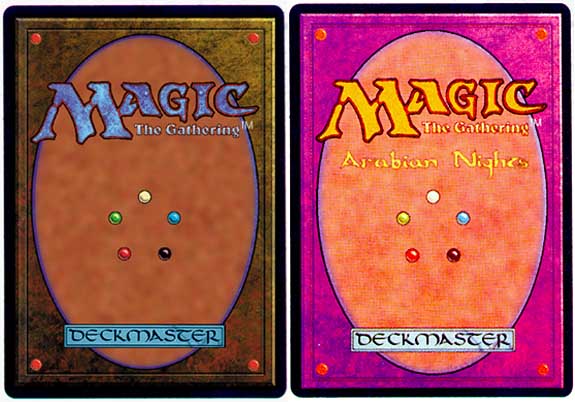Arabian Nights
Arabian Nights was the first true expansion set to Magic the Gathering after the unlimited run. It was originally meant to be released as a standalone game and was only converted into an expansion at the last second. This lead to a lot of shonkiness and muddled design, though nothing on the level of certain other mistakes of the era. Despite all the issues it was a success and generated some iconic cards that are still used to this day. It was the last set before Magic's popularity really took off, and as such many of the cards can still be ebayed for incomprehensible amounts of money. The Magic the Gathering video game (commonly known as Shandalar) uses an unusual cube of the original set (with a defacto ban on the Power Nine), The Dark, this set and some gimmick cards with random effects only possible in a video game.
Notable Cards[edit | edit source]
Shahrazad[edit | edit source]
The first of a very short list of cards banned from every tournament format, everywhere, forever. It was grotesquely abusive and lent itself to all manner of awful strategies. Matches would take forever and often go to time. Due to weird rulings that are no longer in place, if 1 card got removed from a subgame, it was removed from the games above it. It was even took up to much playing space because the initial game needed left alone while the players played a subgame near by. During this time Arabian Nights featured no deck or card limits. It was theoretically possible to construct a deck of nothing but Mox Pearls and Shahrazads, trapping your opponent in an infinite fractal nightmare of subgames. If they didn't concede they would usually lose at game number 5^7 from deck attrition. Also, with the old mulligan rule, the deck's opponents couldn't mulligan to lower their starting hand size (simultaneously increasing their library's starting hand size). Lastly, with the old mulligan rule, it worked by revealing all the cards in your hand and if you had all lands or all non-lands you could mulligan (once per game). Shahrazad is probably Richard Garfield's favorite card, and he thinks it is a reasonable card... for casual play, but will admit (without being asked) that a card like this has no place in competitive play [1]. Also casting Shahrazad in a subgame is a flavor win. A Thousand and One Nights had stories within stories, going even 6 or 7 layers deep.
Ali from Cairo[edit | edit source]
Like a tiny 4 drop Platinum Angel, Ali bounced from tournament to tournament causing apocalyptic levels of anal devastation everywhere he went. Eventually creature removal abilities proliferated enough to deal with him in later editions, but by then he'd done his damage.
City of Brass[edit | edit source]
Aside from any form of lotus of moxen powered bullshit City of Brass was one of the best mana generation tools in the game. For most purposes it is generally now considered inferior to Mana Confluence, as there are situations where something like an Urborg is in play, Mana Confluence can give you mana without making you lose life (that specific example only generates black mana, which of course can also pay for generic costs). Additionally Mana Confluence doesn't hurt you if the land gets tapped for a reason other than you tapping for mana. That said, Mana Confluence can't tap use it's mana ability if there is preventing you from paying life, (e.g. controlling a Platinum Emperion or having less than 1 life). Additionally if you can win at instant speed and you need 1 mana to do it and are at one life, you can tap City of Brass for that mana and respond to the trigger that damages you and win using the mana from City of Brass with the City of Brass damage trigger still on the stack, where as tapping for the mana with Mana Confluence (if something like the Urborg situation above isn't around) will cost you life and will happen as you tap for mana, causing you to lose the game before you get do do that thing you could have otherwise won the game with. Lastly life loss can't be prevented where as damage can (or is at least life loss is much harder to, especially if it is a cost, as is the case with Mana Confluence).
Juzam Djinn[edit | edit source]
A sad lesson in how power creep ruins everything good. Juzam used to be the premiere aggro card in the game, but has since fallen by the wayside as strictly better cards were introduced. It's counterparts Erhnam Djinn and Serendib Efreet made strong showings too.
Library of Alexandria[edit | edit source]
Often referred to as the tenth of the Power Nine, Alexandria is a wildly overpowered card that remains one of the best draw generators in the game. It is banned from legacy and is restricted in vintage.
Bazaar of Baghdad[edit | edit source]
Along with Brass and Alexandria, Baghdad forms the trifecta of bullshit land cards printed in this set. if you happen to know what vintage Dredge is, you will know the power of this card
Kird Ape[edit | edit source]
Kird Apes. Taiga. Compare to any other one drop. You can cry now.
What Almost Was[edit | edit source]
This was what Magic could've been like, as the original way to denote what expansion a card was from was to give it an entirely different color scheme on the back. Having a very blatant knowledge of what was coming next in your deck would be grievously unfair, wouldn't it? Cooler heads (plus complaints from players) prevailed, though, and the decision to use an expansion symbol came in practically at the last minute.
Of course, new card backs would require new basic lands. When it was apparent those new lands would no longer be needed, they weren't included in the set... except for Mountains. Mountains stayed in because WotC forgot about them.
| Settings of Magic: The Gathering | |
|---|---|
| Pre-revisionist: | First Magic Sets - First Urza Block - Arabian Nights Legends - Homelands - Ice Age - Mirage |
| Weatherlight Saga: | Portal Starter Sets - Second Urza Block Tempest Block - Masques Block - Invasion Block |
| Post-Weatherlight: | Otaria Block - Mirrodin - Kamigawa - Ravnica - Time Spiral |
| After the Mending: | Lorwyn - Alara - Zendikar - New Phyrexia Innistrad - Return to Ravnica - Theros - Tarkir - Eldraine - Ikoria |
| Two-Block Paradigm: | Kaladesh - Amonkhet - Ixalan |
| Post Two-Block Paradigm: | Eldraine - Ikoria - Kaldheim - Strixhaven |
| Never in a standard set: | Fiora (Where the Conspiracy sets take place) - Kylem (Battlebond) |
